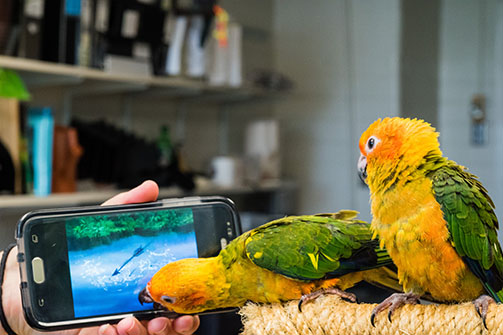Happy Eyes, Happy Minds
Birds are the focus of two stories from the College of Veterinary Medicine & Biomedical Sciences.
.jpg)
Aggies Restore Jeep’s Peepers
Texas A&M ophthalmologists Erin Scott and Lucien Vallone performed an uncommon cataract surgery to restore vision to a blind chinstrap penguin from Galveston’s Moody Gardens.
Jeep, a 30-year-old penguin with cataracts, underwent the successful 45-minute procedure. A second penguin named Takota was also due to undergo surgery, but it was discovered that he was inoperable due to a detached retina.
The operation involved making a small incision into Jeep’s cornea and then using a machine with a needle that vibrates ultrasonically to break up his cataracts. Since Jeep had to remain cool, doctors covered him with cooling blankets and used fans to blow cold air from large ice buckets while monitoring his body temperature.
Due to the operation’s success, two more penguins from Moody Gardens have since received cataract surgery at the Small Animal Hospital, opening the way for this unique procedure to be performed regularly at the college.
 Boosting Birds’ Brains
Boosting Birds’ Brains
To combat the lack of stimulation many pet birds face in captivity, researchers at the Schubot Exotic Bird Health Center developed a video game similar to “whack-a-mole” that can be played by birds on a tablet or phone.
“Picture a pop-up on the screen, and if a bird uses vocalization or movement to ‘scare’ it away, the picture disappears,” said Constance Woodman ’18, a doctoral student who helped develop the game. “Then, the bird gets a treat from an accompanying dispenser.”
For birds like pet parrots, video games can provide much-needed mental and physical stimulation. Furthermore, games can be used as diagnostic tools to detect changes in birds’ brains, hearing and vision.
“Parrots are incredibly intelligent, but it is challenging to provide them with the mental stimulation they require,” said Donald Brightsmith, an assistant veterinary professor. “Physically, it’s not good for them to sit on a perch all day either. They can face some of the same health issues humans face: brittle bones, hardening of the arteries and weight grain. Getting birds to exercise through games like this is extremely beneficial.”